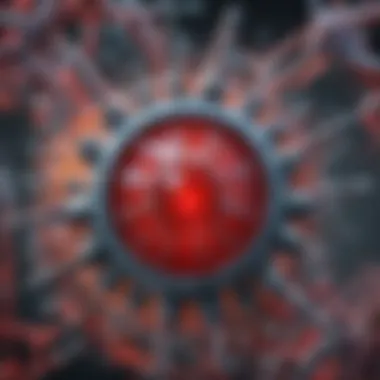Exploring Retroviral Vector Gene Therapy in Medicine


Intro
Retroviral vector gene therapy has emerged as a cutting-edge strategy in genetic medicine, facilitating innovative approaches to treat a variety of genetic disorders and cancers. This therapy involves the use of retroviral vectors, which are modified viruses that transport therapeutic genes into target cells. As we delve into this complex field, it is crucial to understand the underlying mechanisms, applications, and ethical concerns associated with retroviral vector gene therapy. Both researchers and healthcare professionals must grasp the implications of these advancements to harness their full potential.
Research Overview
Methodological Approaches
The research behind retroviral vector gene therapy involves multiple methodologies that span molecular biology, virology, and genetic engineering. Scientists typically employ a range of techniques, including:
- Genetic engineering of retroviral vectors: This process involves altering the genetic material of viruses to enhance their therapeutic capabilities while ensuring safety.
- Cell culture studies: Using cultured cells, researchers can assess the efficacy of gene transfer and expression.
- Animal models: These models are crucial for understanding the in vivo effects of gene therapy before human trials are initiated.
- Clinical trials: These trials test the safety and effectiveness of the therapy in human patients, leading to regulatory approvals.
Through these methodologies, researchers gain insights not just into the vectors themselves but also how they interact with host cells, optimize gene delivery, and provide therapeutic outcomes.
Significance and Implications
The implications of retroviral vector gene therapy are profound. Successful administration of this therapy can lead to significant advancements in treating:
- Genetic conditions such as cystic fibrosis and hemophilia.
- Certain types of cancers, providing new avenues for treatment that traditional methods cannot match.
- Viral infections, for potential eradication by introducing corrective genes into the host’s genome.
Moreover, understanding the significance extends beyond patient outcomes. Technological advancements drive collaborations across disciplines, paving the way for improved biotechnological tools and methods.
"As retroviral vector gene therapy progresses, it becomes increasingly crucial to examine not only the scientific aspects but also the ethical ramifications of its use."
Current Trends in Science
Innovative Techniques and Tools
In the fast-evolving landscape of gene therapy, several innovative techniques and tools have emerged, including:
- CRISPR-Cas9: This groundbreaking tool allows for precise editing of genes, potentially enhancing the effectiveness of retroviral vectors.
- Next-generation sequencing: This technology aids in understanding genetic variations which may influence therapy outcomes.
- Bioinformatics tools: These are essential for analyzing data and predicting the results of gene therapy, promoting efficient research.
Such advancements not only improve the efficiency of retroviral vector deployment but also help identify the best candidates for treatment and monitor long-term effects.
Interdisciplinary Connections
The interdisciplinary nature of retroviral vector gene therapy means that expertise from various fields, including molecular genetics, immunology, and bioethics, come into play. Collaborative efforts often result in:
- Enhanced safety profiles of therapeutic vectors.
- More effective treatment protocols tailored to individual genetic profiles.
- Balanced discussions surrounding the ethical implications of gene manipulation.
Fostering these interdisciplinary connections is essential for the robust development of retroviral vector gene therapy as a reliable treatment option, underscoring its relevance in the modern medical landscape.
Prelude to Gene Therapy
Gene therapy presents profound possibilities in the realm of medicine. It focuses on the delivery of therapeutic genes to replace or repair dysfunctional genes in a patient’s cells. This approach has the potential to address various genetic disorders and diseases that currently have limited treatment options. The significance of gene therapy lies in its ability to tackle the root causes of diseases on a molecular level, thereby offering lasting solutions rather than just alleviating symptoms.
The advancements in gene therapy have coincided with the development of various vector systems for gene delivery. Among these, retroviral vectors have emerged as a prominent method due to their efficiency in integrating therapeutic genes into host cell genomes. This will be a focal point of later sections, highlighting the various types and their applications.
In discussing gene therapy, several critical elements must be considered: safety, efficacy, and ethical implications. The infusion of new genetic material must be conducted with utmost safety to avoid adverse effects, such as immunogenic reactions, that could limit therapeutic success. It is also essential to discuss the appropriateness of gene therapy for different patients, including factors such as age, overall health, and type of genetic disorder.
Understanding these aspects is key for students, researchers, educators, and professionals engaging with contemporary medical challenges. The journey through gene therapy is not simply about the treatment itself; it encompasses an exploration of innovative solutions grounded in bioethics and translational research.
Retroviral Vectors Explained
Retroviral vectors are an essential tool in gene therapy. They play a crucial role in delivering therapeutic genes into targeted cells. Understanding retroviral vectors is fundamental for those interested in biomedical research, particularly in gene therapy. These vectors allow for stable integration of genes into the host genome. This capability has been pivotal in treating various genetic disorders and cancers. As this article progresses, emphasis will be placed on the different types and structures of retroviral vectors. Also, the benefits and limitations will be highlighted, giving readers a comprehensive view of their application in modern medicine.
Basic Structure
The basic structure of retroviral vectors is rooted in their viral origin. They typically consist of a viral envelope, a core, and RNA genomes. The envelope is composed of proteins that facilitate entry into host cells. Once inside, the RNA genome is reverse-transcribed into DNA, which integrates into the host's DNA. This integration is key as it allows the therapeutic gene to be expressed in the target cells.


The structure can vary between different types of retroviruses, but generally, all share this essential framework. Understanding this structure is critical for the engineering of efficient vectors that can effectively deliver genes.
Types of Retroviral Vectors
There are mainly three types of retroviral vectors frequently used in scientific and clinical applications: Moloney Murine Leukemia Virus (MLV) vectors, lentiviral vectors, and spumavirus vectors. Each of these types has unique characteristics that influence their application in gene therapy.
Moloney Murine Leukemia Virus () Vectors
Moloney Murine Leukemia Virus vectors are one of the most established types of retroviral vectors. They are primarily used in gene therapy for their ability to integrate stable genetic material into host cells. One key characteristic of MLV vectors is their relatively low packing capacity compared to other vectors, which may limit the size of the therapeutic genes they can deliver. However, their high integration efficiency makes them a beneficial choice for applications where gene expression is crucial.
MLV vectors are particularly popular in experimental settings, especially in murine models. Their advantages include simplicity in vector design and the ability to produce high-titer supernatants necessary for gene delivery. However, there are disadvantages, such as immunogenicity and the potential for insertional mutagenesis, leading to concerns about their long-term safety.
Lentiviral Vectors
Lentiviral vectors, derived from the Human Immunodeficiency Virus (HIV), represent a significant advancement in gene delivery systems. One notable aspect of lentiviral vectors is their ability to infect dividing and non-dividing cells. This characteristic expands their use in various therapeutic contexts. Lentiviral vectors accommodate larger genomic inserts compared to MLV vectors, which is advantageous for delivering complex therapeutic genes.
Their unique feature is the ability to achieve stable gene expression without triggering significant immune responses. This makes them a popular choice in clinical applications. On the downside, concerns exist regarding their potential to induce replication-competent viruses, which poses safety risks in therapeutic applications.
Spumavirus Vectors
Spumavirus vectors, also known as foamy virus vectors, are less common than MLV and lentiviral vectors but have unique contributions to gene therapy. They are characterized by their capacity to accommodate large genetic payloads. This is especially beneficial for delivering large therapeutic genes or multiple genes simultaneously. They establish stable long-term gene expression without significant cytotoxic effects in target cells.
A key advantage of spumavirus vectors is their low immunogenicity, as the immune system is less likely to react to these vectors. However, they are not as well-studied as lentiviral or MLV vectors, resulting in less understanding about their efficacy and potential drawbacks.
In summary, understanding the various retroviral vectors and their specific features is paramount for harnessing their full potential in gene therapy. Each vector type offers unique benefits and challenges, which must be considered in the quest for effective treatments.
Mechanism of Retroviral Gene Transfer
Understanding the Mechanism of Retroviral Gene Transfer is a critical aspect of advanced genetic therapies. Retroviral vectors are not merely tools for delivering genes; they represent a sophisticated interplay between viral biology and gene therapy applications. Knowing how retroviruses insert their genetic material can enhance therapeutic advantages, improve efficacy, and reduce potential risks associated with gene therapy. This section explores the two fundamental phases of retroviral gene transfer: the entry into target cells and the subsequent integration of viral DNA.
Entry into Target Cells
The entry of retroviral particles into target cells is vital for successful gene therapy. Retroviral vectors utilize specific receptors on the cell surface for entry. This process often begins with the retrovirus recognizing and binding to these receptors, initiating endocytosis. Once inside the cell, the retroviral genome is released, preparing it for integration into the host's DNA.
Several factors influence the efficiency of cell entry:
- Tropism: Different retroviruses have varying preferences for cell types based on receptor expression. For instance, the Moloney Murine Leukemia Virus (MLV) predominantly targets mouse cells, while lentiviral vectors can transduce both dividing and non-dividing human cells.
- Cell Cycle: The stage of the cell cycle can also affect retroviral entry. Retroviruses typically target actively dividing cells, as the integration phase is closely linked to cell division.
- Concentration of Vectors: Higher concentrations of viral vectors can lead to increased chances of successful entry, but may also pose safety concerns.
This phase not only sets the foundation for successful gene integration but also plays a role in determining the specificity and overall effectiveness of the vector used.
Integration of Viral DNA
Following entry, the viral genome must integrate into the host genome for effective expression of the therapeutic gene. This integration is critical as it allows the introduced gene to be replicated and expressed in conjunction with the host's DNA during cell division.
Integrative mechanisms of retroviral vectors typically involve the following steps:
- Reverse Transcription: Once inside the cell, the viral RNA genome is converted into DNA through reverse transcription. This step is pivotal because it enables stable genetic information to be formed from the viral RNA.
- Integration: After reverse transcription, the viral DNA is inserted into the host genome by the viral integrases. The choice of integration site can vary, presenting both therapeutic potential and risk factors. Integration sites near active genes may enhance expression, but can also disrupt critical host genes leading to adverse effects.
- Transcription: Following integration, the host cell machinery recognizes the integrated viral DNA as part of its genetic material, allowing transcription and subsequent expression of the therapeutic gene.
"Proper integration of viral DNA is crucial. Mistakes in this process can disrupt normal cellular functions and lead to unexpected outcomes."
Challenges during this stage may include off-target effects and insertional mutagenesis. Researchers are continuously working to refine vector design and delivery methods to mitigate these risks while enhancing the overall effectiveness of retroviral gene therapies. This continuous evolution underscores the potential of retroviral vectors in the landscape of genetic medicine.
Applications of Retroviral Vector Gene Therapy
The applications of retroviral vector gene therapy represent a significant area of interest in modern medicine. This field is crucial for treating various diseases that have eluded more traditional treatments. Retroviral vectors function as tools to introduce therapeutic genes into patients' cells, thus altering their genetic makeup to combat diseases. Understanding these applications is essential for recognizing the broader implications of gene therapy in healthcare.
The benefits of retroviral vector gene therapy extend beyond mere functionality; they bring hope to patients suffering from genetic disorders and cancer. By delivering corrected genes to dysfunctional cells, these vectors can effectively restore normal function. Consideration of this approach has grown, particularly as research validates its potential effectiveness.
Among the key considerations in this field are safety, delivery mechanisms, and patient eligibility. Choosing appropriate vectors is vital to reduce the risk of unexpected immune responses or insertional mutagenesis. Ongoing advancements drive improvements in vector technology, aiming to enhance efficacy while maintaining patient safety. Furthermore, the thorough understanding of genetic variations among patients invites a more personalized approach to treatment.


Treatment of Genetic Disorders
Genetic disorders arise from abnormalities in genes that can disrupt normal bodily functions. These conditions often have severe implications, affecting both individual quality of life and overall health. Retroviral vector gene therapy offers a promising avenue for correcting faulty genes responsible for such disorders.
Common examples include severe combined immunodeficiency and hemophilia. In these cases, retroviral vectors can deliver healthy copies of the genes, which can lead to drastic improvements in patient health. Research has shown that effective gene transfer can restore the function of defective genes, making this treatment a pivotal element in managing these conditions.
- Safety and Efficacy: Trials have demonstrated both safety and efficacy. However, the risk of insertional mutagenesis remains a concern, requiring careful vector selection.
- Patient Outcomes: Reports of successful gene therapy treatments have yielded significant improvements in clinical outcomes for many patients, highlighting the need for ongoing research and application.
Cancer Gene Therapy
Cancer presents a unique challenge in medical treatment due to its complex nature and varying genetic profiles. Retroviral vector gene therapy offers innovative solutions to target cancer cells specifically. This application can drive the development of tailored therapeutic strategies.
The concept of inserting genes that induce apoptosis in cancer cells or boost the immune response against tumors represents a significant breakthrough. For instance, certain vectors can deliver genes encoding for anti-tumor antibodies, aiding the body in its fight against malignancies. Assessing these methods shows promising results in pre-clinical and clinical settings.
- Combination Therapies: Often, retroviral gene therapy is utilized alongside traditional treatments, such as chemotherapy or radiotherapy, enhancing overall efficacy.
- Transformative Potential: The application of gene therapy in oncology reflects a shift towards more precise treatment regimens, creating a more adaptable therapeutic landscape.
Clinical Trials and Efficacy
Clinical trials serve as a vital component in the assessment of retroviral vector gene therapy. Their purpose is to evaluate the safety and effectiveness of treatments before they are officially approved for public use. In this field, where innovative therapies are rapidly evolving, clinical trials provide essential data that can guide future research and therapeutic strategies.
One of the primary benefits of clinical trials is their role in establishing the efficacy of retroviral vectors. Efficacy refers to the ability of a treatment to produce a desired effect under controlled conditions. As retroviral vectors are manipulated to treat various genetic disorders and cancers, demonstrating their effectiveness through rigorous trials ensures that patients receive reliable and safe therapies. Each study typically involves various phases that help refine dosages, assess side effects, and measure patient responses.
Furthermore, clinical trials offer insights into long-term outcomes and potential complications that may not be evident in initial studies. Researchers can track the long-term safety and possible durability of the treatment, which is particularly significant when addressing chronic conditions. By understanding these elements, medical practitioners can make informed decisions about introducing gene therapies into clinical practice.
“Clinical trials are crucial for translating discoveries into real-world applications.”
In addition, these trials provide a framework for regulatory approval. Regulatory agencies like the Food and Drug Administration (FDA) require extensive trial data to ensure treatments are both safe and effective before they can enter the market. This process ultimately protects patients and builds trust in gene therapy technologies.
Despite the promising aspects of clinical trials, there are challenges that can arise. The selection of appropriate patient populations, potential biases in study design, and the complexity of measuring outcomes can complicate the results. It is essential for researchers to use stringent protocols to minimize these issues, ensuring that the findings are valid and applicable to a broader audience.
Through continuous refinement of methods and designs, the field of retroviral vector gene therapy can evolve. The information derived from these trials not only contributes to immediate therapeutic applications but also sets the stage for future innovations in genetic medicine.
Successful Case Studies
Case studies of retroviral vector gene therapy demonstrate both practical applications and efficacy in treating various diseases. One of the most notable examples is the use of lentiviral vectors to treat X-linked severe combined immunodeficiency (X-SCID). This condition, caused by a mutation in the IL2RG gene, leads to a deficiency in immune function. In clinical trials, patients treated with gene therapy using lentiviral vectors have exhibited sustained immune responses and significant improvement in overall health.
Another meaningful case study involves the treatment of certain types of leukemias using engineered T-cells, modified through retroviral vectors. In these treatments, T-cells are edited to recognize and attack cancer cells more effectively. The success rate of these therapies has brought renewed hope to patients who have not responded to traditional treatments. Both studies underscore the potential of retroviral vectors as powerful tools in the fight against genetic diseases and cancers.
Challenges in Clinical Implementation
Implementing retroviral vector gene therapy in clinical settings presents several hurdles. One primary challenge is the safety concerns related to insertional mutagenesis, where the integration of the viral DNA into the host genome can disrupt normal gene function and potentially lead to malignancies. This risk necessitates ongoing vigilance and monitoring of patients receiving these therapies.
Moreover, immune responses against the vector or the transgene itself can diminish the efficacy of the treatment. The human immune system may recognize the vector as foreign and mount a defense, limiting the therapeutic impact. Researchers are actively exploring methods to mitigate these immune reactions, like improving vector design or utilizing immunosuppressive therapies.
Finally, there are practical issues to consider, such as the high costs associated with these therapies and ensuring equitable access for diverse patient populations. The complexities of manufacturing and delivering gene therapies further complicate the landscape. These challenges underscore the need for comprehensive strategies in regulatory frameworks that ensure patient safety while advancing the field of retroviral vector gene therapy.
Challenges and Limitations of Retroviral Vectors
Retroviral vector gene therapy offers significant promise in treating genetic disorders and cancers, but this potential is not without its challenges and limitations. Understanding these aspects is vital for advancing the field. Identifying safety concerns and immune responses is crucial in ensuring the efficacy and safety of treatments. As research progresses, a comprehensive grasp of retroviral vectors' challenges can help streamline their application in clinical settings.
Safety Concerns
One of the most pressing issues related to retroviral vectors is safety. The integration of viral vectors into the host cell's genome can lead to unintended consequences. This could result in insertional mutagenesis, where the integration disrupts critical genes or regulatory elements. This disruption has the potential to lead to oncogenesis, causing unregulated cell growth and cancer.
Additional safety concerns include the possibility of generating replication-competent viruses during vector production. If these viruses were to infect cells, they could propagate in the host, posing significant risks. Evaluating these risks is crucial before deploying retroviral vectors in clinical trials.
Persistent Immune Responses
Another major challenge is the persistent immune response triggered by retroviral vectors. When these vectors are introduced into the body, the immune system may recognize them as foreign entities. This recognition can lead to the development of neutralizing antibodies and T-cell responses against the vector and even the transgene product.


Such immune responses can reduce the efficacy of the therapy. A heightened immune reaction can lead to the elimination of the therapeutic gene product before it has a chance to achieve its intended therapeutic effect. This reality emphasizes the need for better vector engineering and optimized delivery methods to evade immune detection. Strategies could include the use of immunosuppressive medications or developing vectors that can escape immune surveillance.
The understanding of safety concerns and immune responses is essential for the successful application of retroviral vector gene therapy.
Addressing these challenges requires not only scientific innovation but also careful consideration of regulatory requirements. Regulatory bodies need to establish stringent guidelines to ensure patient safety while permitting the advancement of gene therapy. Collaborations among researchers, clinicians, and regulators are necessary to drive this field forward.
Future Directions in Retroviral Gene Therapy
The future of retroviral vector gene therapy is promising and multifaceted. As researchers continue to explore the potential of this technology, several important trends emerge that could significantly impact its application in medicine. These developments not only enhance the efficacy and safety of retroviral vectors, but also broaden the scope of conditions that can be treated. Understanding these innovations is essential for both current and future practitioners in the field.
Innovations in Vector Design
Innovations in vector design are pivotal in achieving better outcomes in gene therapy. Modern advancements focus on optimizing the retroviral vectors to enhance their efficiency and specificity. One notable innovation is the engineering of lentiviral vectors with improved safety profiles. By implementing self-inactivating (SIN) configurations, researchers minimize the risk of insertional mutagenesis, a key concern in gene therapy. Additionally, the use of synthetic promoters allows for more targeted expression of therapeutic genes, potentially reducing off-target effects.
Furthermore, advances in nanoparticle technology hold promise for retroviral vector delivery. These nanoparticles can facilitate a more efficient introduction of the vectors into cells and improve stability during transport. Another innovation involves the development of dual-variable modules, which can target specific cell types, leading to enhanced transduction rates. This targeted approach decreases the chance of immune reactions and increases therapeutic efficacy.
Potential for Personalized Medicine
The potential for personalized medicine represents a transformative direction in retroviral vector gene therapy. Personalized medicine aims to tailor treatments according to individual genetic profiles, thereby improving therapeutic outcomes. With the advancements in genomics and bioinformatics, it is now feasible to analyze patients' specific genetic mutations and determine the most suitable gene therapy approach.
The integration of gene editing techniques like CRISPR with retroviral vectors further underscores the potential for personalized applications. For instances where patients exhibit unique genetic disorders, combining these technologies enables the precise correction of mutations at the DNA level.
Moreover, as the understanding of individual immune responses grows, retroviral vectors can be designed to suit patients' immune landscapes, making treatments more effective and reducing the risk of adverse reactions. This level of customization not only enhances treatment efficacy but also encourages better patient compliance, as patients may experience fewer side effects and improved health outcomes.
"As we innovate in vector design and embrace personalized medicine, retroviral gene therapy stands at the frontier of therapeutic advancements, poised to alter the landscape of genetic medicine."
In summary, the future of retroviral vector gene therapy is rich with possibilities. Innovations in vector design and a shift toward personalized medicine could provide unprecedented opportunities for treating a variety of genetic disorders and cancers, ultimately paving the way for a new era in genetic intervention.
Regulatory Landscape
The regulatory landscape in retroviral vector gene therapy is vital for ensuring patient safety and efficacy of the therapies developed. A thorough regulatory framework not only fosters innovation in gene therapy but also protects patients from potential risks associated with novel treatments. Regulatory agencies are responsible for overseeing the development, testing, and approval of these therapies, ensuring they meet rigorous scientific and ethical standards.
Guidelines for Clinical Use
Regulatory guidance plays a key role in clinical applications of retroviral vector gene therapy. These guidelines govern various aspects such as the design of clinical trials, evaluation of results, and necessary precautions for patient care. Important elements include:
- Preclinical Studies: Before clinical trials can begin, comprehensive studies involving laboratory and animal models are necessary. This phase assesses the initial safety and biological activity of the retroviral vectors being developed.
- Phase I Trials: These trials focus on safety. They evaluate the vector's effects on human subjects and help determine safe dosage levels.
- Phase II Trials: With an emphasis on efficacy, these trials assess how well the therapy works in treating targeted conditions.
- Phase III Trials: These expanded trials compare the new therapy against existing treatments in larger patient groups, establishing effectiveness and safety in a broader context.
Following successful trials, regulatory bodies like the U.S. Food and Drug Administration (FDA) and the European Medicines Agency (EMA) review the findings thoroughly before granting approval for general clinical use. Transparent reporting and adherence to established guidelines build trust in the gene therapy process.
Ethical Considerations
The ethical dimensions involved in retroviral vector gene therapy necessitate serious contemplation. Researchers and healthcare providers must navigate the delicate balance between innovation and morality. Key considerations include:
- Informed Consent: Patients participating in clinical trials must fully understand the procedures and potential risks involved. This ensures they can make knowledgeable decisions about their treatment options.
- Equity in Access: As gene therapy progresses, ensuring that it is accessible to a diverse patient population remains a challenge. Researchers must actively strive for equity in the distribution of these treatments.
- Long-term Effects and Monitoring: Understanding the long-term implications of gene therapy is critical. Ongoing monitoring after treatment is necessary to identify late-emerging side effects and assess the sustained efficacy of the interventions.
In summary, the regulatory landscape surrounding retroviral vector gene therapy holds immense importance. It comprises intricate guidelines for clinical use and incorporates essential ethical considerations to guarantee patient welfare. This landscape ultimately shapes the future of gene therapy, influencing both scientific progress and patient outcomes.
Ending
The conclusion serves as a critical synthesis of the entire discussion surrounding retroviral vector gene therapy. This section highlights how such therapies emerge as essential tools in addressing complex genetic disorders and cancers. Their ability to deliver genes into the cells effectively not only showcases advancements in biotechnology but also underscores the transformative potential within medicine.
In aggregating significant findings, it is essential to reemphasize that retroviral vectors, such as lentiviral and Moloney Murine leukemia virus vectors, stand at the forefront of gene therapy endeavors. They provide specific advantages, including persistence of gene expression and broader target cell range, enabling treatments that were once deemed impossible.
Moreover, while clinical applications are promising, the challenges discussed in previous sections play a vital role in shaping future directions for research and development. Considerations regarding safety and immune response evoke a sense of cautious optimism, reminding stakeholders to remain diligent as they advance this field.
Summary of Key Points
- Retroviral vectors are integral for delivering therapeutic genes into patient cells.
- Various types of retroviral vectors, including lentiviral and MLV vectors, show specific advantages in gene therapy.
- Clinical trials present both successful case studies and obstacles that must be navigated for widespread implementation.
- Safety concerns and immune responses necessitate a risk-benefit analysis before clinical application.
- Innovations in vector design earmark the future of retroviral gene therapy as a customizable and effective treatment option.
Implications for Future Research
The advances in retroviral vector gene therapy open avenues for future research that extend beyond traditional boundaries. As seen, there is a notable emphasis on personalized medicine, which is driving the need for more nuanced vectors. Future research should focus on the following aspects:
- Enhanced vector efficiency: Refining the engineering of vectors to improve their targeting and integration capabilities.
- Long-term safety studies: Conducting extensive research into the long-term implications of retroviral gene therapy on patients’ health.
- Regulatory frameworks: Developing robust guidelines that address both ethical and safety concerns surrounding the use of gene therapies.
- Integration of artificial intelligence: Employing AI technologies in vector design to optimize outcomes and minimize risks.
- Collaboration between disciplines: Encouraging collaboration among biologists, bioethicists, and legislators to cultivate a comprehensive approach towards advancements in gene therapy.



